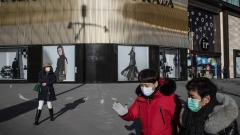Feb 4, 2021
What a US$92 million painting says about new art market values
, Bloomberg News
Christie's Sees Resilience in Art Market Amid Pandemic
In the lead-up to its auction in New York, Sotheby’s sent a 15th century painting by the early Italian Renaissance artist Sandro Botticelli on a world tour, traveling from New York to Dubai, London, and Los Angeles in an effort to drum up interest.
While the painting was in London, a group of dealers, collectors, and curators who’d gathered to admire it got to talking: Was the “in excess of US$80 million” estimate reasonable for an exquisitely preserved portrait of a beautiful young man in a sumptuous mauve doublet? Opinions varied to such a degree that an informal wager began. Everyone wrote down their bet on a piece of paper; the furthest from the correct price would have to buy the rest of them dinner.
It was a fun idea at first, “but now it’s become a real problem,” says Jorge Coll, co-chief executive officer of the old masters gallery Colnaghi, founded in London in the 18th century. “More people have joined the bet, and now the guy who’s lost is going to have to pay for an expensive dinner.”
Portrait of a Young Man Holding a Roundel eventually hammered on Jan. 28 for US$80 million. Auction house fees brought the total to $92.2 million. When this Botticelli was last available, almost 40 years ago, it sold to the real estate billionaire Sheldon Solow for about US$1.3 million. The auction yielded his private foundation (Solow died in November) an almost 7,000 per cent return. The highest public sale of the artist’s work prior to this was in 2013, when a small painting of the Madonna sold for US$10.4 million.
Coll and his friends weren’t the only ones speculating about the estimate. Most experts couldn’t agree on what it was worth, because Sotheby’s valuation was without precedent. “No Botticelli has sold for anything like this,” said the dealer Patrick Matthiesen before the sale started. “I think the price for this picture should be US$30 million to US$50 million. Having said that, I don’t dispute for a minute that it could clear [US$80 million] in a moment.”
But some dealers argued there actually was a precedent—it just had nothing to do with Botticelli. The benchmark for the portrait’s sale, the argument goes, had been set by other artists—including Jeff Koons’s Rabbit (US$91 million at Christie’s in 2019), a painting of a skull by Jean-Michel Basquiat (US$110.5 million at Sotheby’s in 2017), and, most significantly, a painting of Jesus Christ by Leonardo da Vinci.
When Salvator Mundi sold for US$450 million at Christie’s New York in 2017, it became easily the most expensive painting to ever sell at auction. More than that, though, it was a lesson to art dealers everywhere: A select group of very, very wealthy people are willing to pay for the best—or at least, the best-available—example of an artist’s work, assuming of course the artist is famous. The only question, then, is how convincingly sellers can make the case.
“The people at Christie’s who created the [promotional] video for Salvator Mundi should have won an Oscar,” Coll says. The video in question, The Last da Vinci: The World Is Watching, is a four-minute film that shows rapid-fire clips of people of every age, race, and class staring at the picture, often weeping—the actual work of art is never shown. “They took the painting out of the equation,” Coll says. “When you look at something like that, it’s the same emotion as when you’re listening to your national anthem. How can you value that?”
Christopher Apostle, head of old master paintings at Sotheby’s, has a slightly different explanation for the Botticelli’s evaluation, but it still comes back to the notion that so-called masterpieces are in a class unto themselves. “I didn’t sort of think, ‘Oh, I can make this into a cultural phenomenon,’ ” he says, adding that the Leonardo sale was proof of nothing more than “at auction, sometimes things happen.”
Instead, Apostle says, “you’ve got to look at the whole panoply of what a masterpiece is, and I don’t think there’s a difference between a masterpiece by Basquiat or Rembrandt or Botticelli.” In other words, Young Man Holding a Roundel shouldn’t be valued against other Botticellis; rather, it should be valued as the best possible version of a work of art by a superstar artist. “I’ve always felt that this was a picture that’s in its own category,” Apostle says. “I looked at Picasso and Basquiat as much as I did any other old master.”
That might sound like hype, but there’s almost unanimous consensus that this Botticelli is, in fact, the finest portrait still in private hands. “Without any doubt it’s the best old master painting to come to market in the last 10 years, and for me, past 20 years,” says Fabrizio Moretti, founder of the Moretti Gallery in London. “I deal in this period, and it’s so rare to find a painting [like this] in great condition.”
Most recently, Carlo Orsi, a dealer in London and Milan, brought another Botticelli portrait to the 2019 Frieze Masters art fair in London. Valued at about US$30 million, the work “was a very well-known portrait, full of history,” Orsi says, but he notes that the Spanish government had it listed as a work of cultural interest, meaning it couldn’t leave the country for long. Given the painting’s temporary export license, he says, the price was suppressed. It failed to find a buyer.
“When you look at something like that, it’s the same emotion as when you’re listening to your national anthem. How can you value that?”
Despite that setback, Orsi stridently supports the valuation of Young Man Holding a Roundel. “If you want another one like this, you could steal it from a museum,” he says, “but there aren’t any others.”
It’s an argument that surely resonated with the work’s buyer, whose identity is still unknown as of press time, though art world whispers suggest it could be a Russian oligarch. During the bidding, Sotheby’s auctioneer Oliver Barker, set up in the house’s streaming-audience-only stage set, opened at US$70 million. Only two bidders—both on the phone to auction house specialists—stepped up to the plate; one seemed to back down after a single bid. It still took four minutes for the hammer to fall as Barker attempted to coax the collector back into the fray. The total certainly was “in excess of US$80 million,” as Sotheby’s predicted, but not much more than that.
This wasn’t great news for Coll, who’d bet that it would sell for US$200 million and is now on the hook for a very expensive meal. “It’s going to be 10 people at a good restaurant,” he says. “At one point I was thinking I should bid for the painting, because it’s going to be cheaper than the dinner.” Still, he says, it could be worse. “If it went unsold, I would still have to pay, and we’d have nothing to celebrate. Because if the old masters world can still produce US$100 million sales, that makes me happy.”
4,999 Luxuries for the Price of a Masterpiece
What else can you purchase that adds up to $92 million?
2,580 Bottles of Bowmore’s 30-year-old Scotch
Start by buying up the entire collection of Bowmore’s new single malt, which has been aged in the distiller’s best sherry hogsheads and bourbon barrels. $2,500 per bottle
29 Ferrari F8 Tributos
The most beautiful Ferrari in a decade has a 3.9-liter, 711-horsepower engine that pays tribute to the powerful V-8s of the brand’s illustrious past. $270,530 each
645 Bottles of 2017 Domaine de la Romanée-Conti
The ultrarare Romanée-Conti label is a collector’s dream. $15,500 per bottle
391 Bitcoin
If the cryptocurrency tanks, you’d lose $13 million—about the cost of the auction house’s premium. $33,900 apiece as of Feb. 1
325 Birkin bags
Not that you can actually buy this many ever, but just trying to could bump you to the front of the line. From $9,850 each
1,028 Rolex Datejust watches
The timepiece preferred by U.S. presidents— Joe Biden wore one in steel to his inauguration—is also available in 18-karat white gold with diamonds. From $16,050
1 Private island
End your spree with this 257-acre property in the lower Exuma Cays of the Bahamas. It includes a 1,700-square-foot main house, three guest houses, utility buildings, and staff accommodations. $35 million



